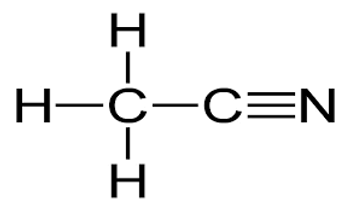Description
Acetonitrile, anhydrous, 99.8%, 1L
Synonym(s):
ACN, Cyanomethane, Ethyl nitrile, Methyl cyanide
Linear Formula:
CH3CN
CAS Number:
75-05-8
Molecular Weight:
41.05
Beilstein:
741857
EC Number:
200-835-2
MDL number:
MFCD00001878
eCl@ss:
39031501
PubChem Substance ID:
57648217
NACRES:
NA.21
grade
anhydrous
Quality Level
200
vapor density
1.41 (vs air)
vapor pressure
72.8 mmHg ( 20 °C)
assay
99.8%
form
liquid
autoignition temp.
973 °F
expl. lim.
16 %
technique(s)
solid phase extraction (SPE): suitable
impurities
<0.001% water
<0.005% water (100 mL pkg)
evapn. residue
<0.0005%
color
colorless
refractive index
n20/D 1.344 (lit.)
bp
81-82 °C (lit.)
mp
−45 °C (lit.)
solubility
water: soluble (completely)
density
0.786 g/mL at 25 °C (lit.)
SMILES string
CC#N
InChI
1S/C2H3N/c1-2-3/h1H3
InChI key
WEVYAHXRMPXWCK-UHFFFAOYSA-N
Acetonitrile, an aliphatic nitrile, is widely used as an organic solvent and intermediate in organic syntheses. It is transparent to UV-visible light, which makes it highly applicable in spectrophotometric and fluorimetric techniques. MeCN is utilized as a mobile phase component in many chromatographic techniques, due to its low viscosity, high elution strength and miscibility in water. It also plays a major role as an extractant medium in liquid-liquid extraction, solid-phase extraction or microextraction.
Application
Acetonitrile may be used as a solvent to prepare:
It may also be used as a reactant to synthesize:
- 1,2-Azidoalcohols and 1,2-azidoamines via cerium(III) chloride assisted ring opening of epoxides and aziridines by sodium azide.
- Cyano-bearing indolinones by oxidative arylalkylation of olefins in the presence of palladium catalyst.
It may also be used as a reactant to synthesize:
- Bis (diphenylphosphino) acetonitrile by reacting with n-butyllithium and then with chlorodiphenylphosphine.
- β-Acetamido ketones via coupling reaction with ketones or ketoesters and aldehydes in the presence of cobalt(II) chloride.
100, 12×100 mL in Sure/Seal™
1, 6×1, 2, 4×2 L in Sure/Seal™
18 L in Pure-Pac™ 1
20, 50 L in Pure-Pac™ 2
200 L in Pure-Pac™ 1







